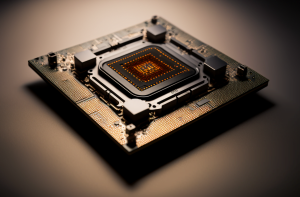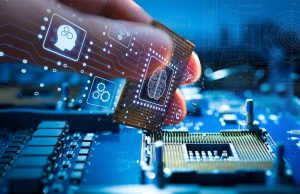From entertainment and autonomous systems to healthcare and banking, artificial intelligence (AI) is now a disruptive force in almost every industry. The subject of how hardware influences AI’s capabilities and future direction is crucial to its development. It is impossible to overestimate the significance of hardware, the physical foundation that makes AI computations possible, even if algorithms and data are frequently highlighted. This blog examines how AI’s capabilities are driven by hardware, the advancements influencing AI hardware, and the potential and difficulties in this quickly changing field.
AI’s Basis: Hardware as the Facilitator
The fundamental infrastructure that AI systems rely on is hardware. For AI systems to process and analyse data, train, and carry out inference tasks, they need a tremendous amount of processing power. AI has developed in tandem with hardware, progressing from simple rule-based systems to complex deep learning networks.

The following are important pieces of hardware that drive AI:
1. CPUs, or central processing units
CPUs are still essential for AI jobs and have long been the workhorses of computing. Their adaptability allows them to handle a variety of tasks, from pre-processing data to running machine learning algorithms for smaller-scale applications, even though they are not explicitly designed for artificial intelligence.
2. GPUs, or graphics processing units
When it comes to AI, GPUs are revolutionary. GPUs were first created for graphic rendering, but they are excellent at parallel computing, which allows them to handle several calculations at once. Because of this feature, GPUs are especially well-suited for deep learning model training, where sophisticated algorithms and big datasets necessitate high-performance parallel processing.
3. Specialised AI chips and Tensor Processing Units (TPUs)
Given the limits of conventional processors for AI, firms such as Google have created TPUs, or hardware tailored for AI activities. The core of deep learning operations, matrix computations, are best served by TPUs and other specialised AI chips like those made by NVIDIA and Intel. The time and expense involved in training and inference have been greatly decreased by these developments.
4. Devices on the Edge
AI is becoming more and more integrated into edge devices like smartphones, IoT sensors, and embedded systems. In order to enable applications such as real-time facial recognition and predictive maintenance, edge AI hardware developments concentrate on providing efficient inference with low energy consumption.
The Feedback Loop Between Hardware and AI
Hardware and AI have a mutually beneficial interaction. More complex AI algorithms are made possible by hardware advancements, and hardware innovation is fuelled by AI demands. Advances in fields like natural language processing and deep learning have been fuelled by this feedback loop. For instance:
Enhanced Computational Power: Ten years ago, it was impossible to train large-scale AI models like GPT-4 and DALL-E, but the development of hardware accelerators has made it possible.
Energy Efficiency: The need for energy-efficient technology is growing along with AI workloads. AI-specific CPUs are made to perform better per watt while having a smaller environmental effect and lower operating expenses.
Miniaturisation: As a result of the demand for edge AI applications, small, potent chips that bring AI capabilities closer to end users have been developed.
Advances Influencing AI Hardware
The need for strong and effective AI systems has spurred a great deal of hardware innovation. Important trends consist of:

1. Computing that is neuromorphic
Neuromorphic chips are designed to resemble the form and operation of neural networks, drawing inspiration from the human brain. These chips have the potential to transform fields like robotics and autonomous systems since they offer reduced power consumption and quicker processing speeds.
2. The use of quantum computing
Although quantum computing is still in its early stages, it has immense potential for artificial intelligence. Beyond the scope of classical systems, quantum computers have the potential to improve machine learning tasks and handle intricate optimisation challenges. Businesses like Google and IBM are making significant investments in this field.
3. Chip Architectures in 3D
The performance and energy efficiency of conventional 2D chip architectures are at their limits. Faster AI computations are made possible by 3D chip architectures, which stack layers of circuits vertically and provide increased data throughput and lower latency.
4. Chips with photonic properties
Photonic chips can dramatically speed up processing and use less energy by transmitting data using light rather than electricity. This development holds great promise for AI applications that rely heavily on data.
Obstacles in the Development of AI Hardware
Even with its quick development, AI hardware still faces a number of obstacles:

1. Price
It is costly to develop and produce cutting-edge hardware. The expense barrier restricts access for researchers and smaller organisations, which could impede the democratisation of AI.
2. The ability to scale
Hardware needs to expand to accommodate the increasing size of AI models. Scaling hardware solutions without correspondingly raising expenses or energy usage is still a major challenge, though.
3. Effects on the Environment
The environmental impact of AI workloads is a worry due to their energy-intensive nature. The long-term sustainability of AI depends on the development of sustainable hardware solutions.
4. Legacy System Integration
Many sectors still use antiquated gear that isn’t AI-optimized. It can be difficult and expensive to integrate new AI-specific hardware into pre-existing systems.
Prospects for the Future
Even though there are obstacles, there are a tonne of prospects for AI hardware in the future:
Democratisation of AI: Access to cutting-edge AI technology will increase as hardware gets more potent and affordable, fostering creativity across sectors.
AI-on-Edge: Advances in small, low-power chips that bring AI capabilities closer to real-time decision-making environments will be fuelled by the growing need for edge AI solutions.
Cross-Disciplinary Research: By working together, computer scientists, hardware engineers, and subject matter experts will develop AI technology that is suited to certain uses.
Sustainability: By investing in green computing technology, AI’s development can be matched with international sustainability objectives, preventing advancement at the price of the environment.
In conclusion,
As the engine that drives algorithms and data processing, hardware is fundamental to the development of AI. In order to satisfy the demands of ever-more complex AI systems, hardware has continuously changed, from CPUs and GPUs to specialised chips and cutting-edge technologies like quantum computing. Even if issues like cost and environmental impact still exist, the rate of innovation presents encouraging answers. By giving sustainable, scalable, and effective hardware top priority, we can unleash AI’s full potential and spur revolutionary change on a global scale. These changes make big global discoveries.